
The UMTS Network and Radio Access Technology: Air Interface Techniques for Future Mobile Systems
Jonathan P. Castro
Copyright © 2001 John Wiley & Sons Ltd
Print ISBN 0-471-81375-3 Online ISBN 0-470-84172-9
SERVICE COMPONENTS IN UMTS
6.1 BACKGROUND
UMTS services will not only offer mobile services supported by 2nd generation systems
such as GSM, but will also expand these services to higher rates and greater flexibility.
The services evolving in the GSM platform through its Circuit Switched (CS) and Packet
Switched (PS) services will continue in UMTS while new services are introduced.
Thus, future UMTS services will have user transmission rates from low bit up to 2
Mbps. Although, high rates will occur primarily within indoor environments, there will
be substantial increases in rates throughout all environments when compared to the
typical 9.4 kbps. Table 6.1 (an extract from Table 2.1) illustrate this increase.
Table 6.1 Range of Transmission Rates
High level
description
Maximal bit rate
(kbits/s)
Maximal speed
(km/h)
Cell coverage
Rural outdoor 144s 500 Macrocell
Suburban outdoor 384 120 Microcell
Macrocell
Indoor/ 2048 10 Picocell
Low range outdoor Microcell
Then the question of the transmission range for UTMS services, is no longer just what
transmission rates, but what type of services, when and where. It is no longer “commu-
nications any where any time”, but “what I want when I want where ever I want”.
Practically, the exploitation of wider transmission rates will facilitate the expansion of
data traffic. As illustrated Table 6.2 there exists a clear trend for the convergence of IP
protocol to wireless, or to what we now call wireless IP. The latter will lead to the Wire-
less Internet, where about 200 M Internet and 300 M mobile subscribers will merge into
1 billion Wireless Internet users.
Table 6.2 Convergence of Internet Protocol (IP) to Wireless
Computer: mobility
high speed services
Telecommunications: mobility
wide services
Media: mobility
personal services
Internet access ISDN services Streaming audio
Electronic mail Video telephony Video on demand
Real time images Wideband data services Interactive video services
Multimedia Location services coupled with
application servers
TV/radio/data contribution
and distribution
Non-voice services will make demands not only on manufacturers and operators but
also from supporting industries, creating a need for new service enablers. However,

232 The UMTS Network and Radio Access Technology
such demand will also introduce new challenges and the need for pragmatic integration
of services and devices, as well as new data processing and managing techniques. These
demands can be summarized as needs as illustrated in Table 6.3.
Table 6.3 Needs for Service Providers and Technology Enablers
Needs for service providers Needs for technology enablers
Strategy for innovative services Well integrated CS and PS system
Economic and spectrum efficiency data pipe Advanced value added platforms (e.g. WAP,
IS, location services, unified messaging, etc.)
Standard interface to phone display Power efficient handsets
Dynamic management control points Effective yet very light device OSs
New and flexible billing systems Text speech
Perception of market needs Speech text
Personalization Intelligent voice recognition
Addressing all user segments Multi-band terminals exploiting software
radio
New data processing and management
techniques
Synchronization
Cost efficient terminals and devices Pragmatic user interfaces (e.g. efficient
portals)
Clearly, the challenges cover all main areas of SW/HW and management technology. In
the forthcoming sections we will see how UMTS addresses these needs and outline the
main approaches and requirements to meet the challenges.
6.2 THE UMTS BEARER ARCHITECTURE
As illustrated in Figure 6.1 after [1], UMTS proposes a layered bearer service architec-
ture, where each bearer service on a specific layer offers its individual services based on
lower layers. Thus, the UMTS bearer service architecture serves as an ideal platform for
end-to-end services providing key features in preceding layers.
(1'72(1'6(59,&(
8076%($5(56(59,&(
7(07
ORFDO
%HDUHU6HUYLFH ([WHUQDO
%HDUHU6HUYLFH
5$',2$&&(66
%($5(5
6(59,&(
&RUH1HWZRUN
%HDUHU
6HUYLFH
5DGLR%HDUHU
6HUYLFH ,X%HDUHU
6HUYLFH %DFNERQH
1HW6HUYLFH
875$
)''7''
6HUYLFH
3K\VLFDO
%HDUHU
6HUYLFH
7( 07 875$ &1,X &1
*
:
7(
Figure 6.1 UMTS bearer service architecture.

Service Components in UMTS 233
Because of its layered-bearer service architecture UMTS permits users or applications
to negotiate, re-negotiate or change appropriate bearer characteristics to carry their in-
formation. Negotiations take place based on application needs, network resource avail-
ability, and demands of quality of service (QoS).
6.3 QUALITY OF SERVICE IN 3RD GENERATION NETWORKS
The main four classes of UMTS traffic differentiated by their delay sensitivity are con-
versational, streaming, interactive, and background. Conversational classes have higher
delay sensitivity than background classes. The first two classes correspond to real time
classes, while the 2nd two to non-real time. Table 6.4 illustrates these classes.
Table 6.4 QoS Classes in UMTS
Traffic class Conversational Streaming Interactive Background
Characteristics
and applications
Preserve time
relation between
information
entities – low
delay (e.g.
voice, video-
telephony)
Preserve also
time relation
between infor-
mation entities
(e.g. multi-
media)
Request re-
sponse pattern
preserving data
integrity. (e.g.
Internet or web
browsing)
Connectionless,
generally packet
communications
preserving data
integrity (e.g.
ftp, email, etc.)
6.4 MULTIMEDIA TRANSMISSION – UMTS TRAFFIC CLASSES
6.4.1 Conversational
Typical speech over CS bearers, voice over IP (VoIP) and video-telephony represent the
conversational class, which in turn represent real-time services. The latter corresponds
to symmetric traffic with end-to-end delay thresholds below 399 ms.
6.4.1.1 Enabling Speech
The adaptive multi-rate (AMR) techniques will enable the UMTS speech codec. This
codec consists of single integrated speech codec with eight source rates controlled by
the RAN, i.e: 12.2 (GSM-EFR), 10.2, 7.95, 7.40 (IS-641), 6.70 (PDC-EFR), 5.90, 5.15
and 4.75 kbps. The use of the average required bit rate has impacts on interference lev-
els, thereby on capacity, and battery life. Logically, lower rates will favour capacity and
battery life duration, but not necessary quality.
The AMR coder [4] works with speech frames of 20 ms, i.e. 160 samples at a sampling
rate of 8000 sample/s. It may switch its bit rate at every frame through in-band signal-
ling or through a dedicated channel. It uses Multi-rate Algebraic Code Excited Linear
Prediction Coder (MR-ACELP) as a coding scheme. We extract CELP parameters at
each 160 speech samples for error sensitive tests. The latter consist of three error classes
(A–C), where class A has the highest sensitivity and requires strong channel coding.
The AMR speech codec can tolerate about 1% frame error rate (FER) of class A bits
without any deterioration of the speech quality. For classes B and C bits a higher FER
can be allowed. The corresponding bit error rate (BER) of class A bits will be about
10
±
.

234 The UMTS Network and Radio Access Technology
AMR allows an activity factor of 50% (while parties have a telephone conversation),
through a set of basic functions:
background acoustic noise evaluation on the Tx to transmit key parameters to the
Rx;
Voice Activity Detector (VAD) on the Tx;
a Silence Descriptor (SID) frame that passes transmission comfort noise informa-
tion to the Rx at regular intervals. This noise gets generated on the Rx in the ab-
sence of normal speech frames.
6.4.1.2 Enabling Circuit Switched Video Telephony
Video telephony has higher BER requirements than speech due to its video compression
features; however, it has the same delay sensitivity of speech. Technical specifications
in [2] UMTS recommend ITU-T Rec. H.324M for video telephony in CS links, while at
present there exists two video telephony options for PS links, i.e. ITU-T Rec. H.323 [5]
and IETF SIP [7]. The H.323 has similar characteristics to H.324M.
The adapted1 H.324 includes essential elements such as H.223 for multiplexing, H.245
for control. It also includes H.263 video codec, G.723.1 speech codec, and V.8bis. I
may have MPEG-4 video and AMR to better suit UMTS services as illustrated in Figure
6.2. Technical specifications include seven phases for a call, i.e. set-up, speech only,
modem learning, initialization, message, end, and clearing. Backward compatibility
occurs through level 0 of the H.223 multiplexing, which is the same as H.324.
9LGHR,2
HTXLSPHQW
5HFHLYHSDWK
GHOD\
9LGHRFRGHF
+RU03(*
6LPSOH3URILOH
+
0XOWLSOH[LQJ
GHPXOWLSOH[LQJ
/HYHO
/HYHO
/HYHO
6SHHFKFRGHF
*
RU$05
$XGLR,2
HTXLSPHQW
8VHUGDWD
DSSOLFDWLRQ7
HWF
6\VWHPFRQWURO
8VHULQWHUIDFH
+FRQWURO
6\VWHPFRQWURO
653/$30
SURFHGXUHV
+0DUHD
'DWDSURWRFROV
9/$30HWF
0RGHP9
99ELV
IRU3671
&RUUHVSRQGLQJ
LQWHUIDFHIRU
ZLUHOHVV
QHWZRUN
0RGHPFRQWURO
9WHU
3671
:LUHOHVV
&LUFXLW
6ZLWFKHG
1HWZRUNHJ
*608076
HWF
Figure 6.2 The ITU Rec. H.324 model.
_______
1 Adapted to wireless from what was originally meant for fixed networks.

Service Components in UMTS 235
The H.324 terminal has an operation mode for use over ISDN links. Annex D in the
H.324 recommendations defines this mode of operation as H.324/I [3]. H.324/I offers
direct inter-operability with the H.320 terminals, H.324 terminals on the GSTN, H.324
terminals operating on ISDN, and voice telephones.
For seamless data communications between UMTS and PSTNs, the UMTS call control
mechanism takes into account V.8bis messages. These messages get interpreted and
converted into UMTS messages and V.8bis, respectively. The latter contains identifica-
tion procedures and selection of common modes of operation between data circuit-
terminating equipment (DCE) and between data terminal equipment (DTE). Essential
V.8bis features include:
flexible communication mode selection by either the calling or answering party;
enabling automatic identification of common operating modes;
enabling automatic selection between multiple terminals sharing common tele-
phone channels;
friendly user interface to switch from voice telephony to a modem based communi-
cations.
6.4.1.3 Enabling Packet Switched Video Telephony
The H.323 ITU-T protocol standard for multimedia (and IP telephony) call control en-
ables PS multimedia communications in UMTS. The standard:
employs a peer-to-peer model in which the source terminal and/or GW is the peer
of the destination terminal and/or GW,
treats gateways (GW) and terminals alike;
requires GWs and terminals to provide their own call control/processing functions;
provides multiple options for voice, data and video communications;
it may employ a gatekeeper function to provide telephone number-to-IP address
translation, zone admission control and other resource management functions.
Figure 6.3 illustrates the H.323 architecture, which incorporates a family of standards
including H225, H245 and H450. As an international standard for conferencing over
packet networks H.323:
acts as a single standard to permit Internet telephony products to inter-operate;
also serves as base for standard interoperability between ISDN- and telephony-
based conferencing systems; and
has the flexibility to support different HW/SW and network capabilities.
The logical channels in H.323 get multiplexed at the destination port transport address
level. The transport address results from the combination of a network address and a
port identifying a transport level endpoint, e.g., an IP address and a UDP port. Packets
having different payload types go to different transport address, thereby eliminating

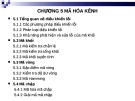

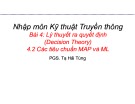






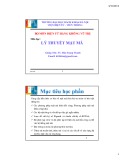

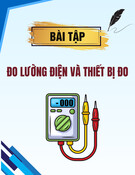

![Bộ tài liệu Đào tạo nhân viên chăm sóc khách hàng tại đơn vị phân phối và bán lẻ điện [Chuẩn nhất]](https://cdn.tailieu.vn/images/document/thumbnail/2025/20251001/kimphuong1001/135x160/3921759294552.jpg)


![Ngân hàng câu hỏi thi giữa kì môn Truyền động điện [Mới nhất]](https://cdn.tailieu.vn/images/document/thumbnail/2025/20250920/kimphuong1001/135x160/42601758354546.jpg)
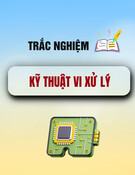
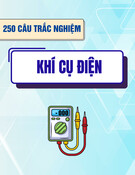
![Câu hỏi ôn tập Quy trình an toàn điện có đáp án [kèm đáp án chi tiết]](https://cdn.tailieu.vn/images/document/thumbnail/2025/20250920/kimphuong1001/135x160/18761758354548.jpg)
![Đề thi trắc nghiệm Kỹ thuật mạch điện tử: Tổng hợp [Năm]](https://cdn.tailieu.vn/images/document/thumbnail/2025/20250920/kimphuong1001/135x160/23481758356189.jpg)

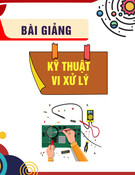
![Tài liệu ôn tập Thông tin quang [năm] [mới nhất]](https://cdn.tailieu.vn/images/document/thumbnail/2025/20250917/anvunguyen0207@gmail.com/135x160/56551758168054.jpg)

